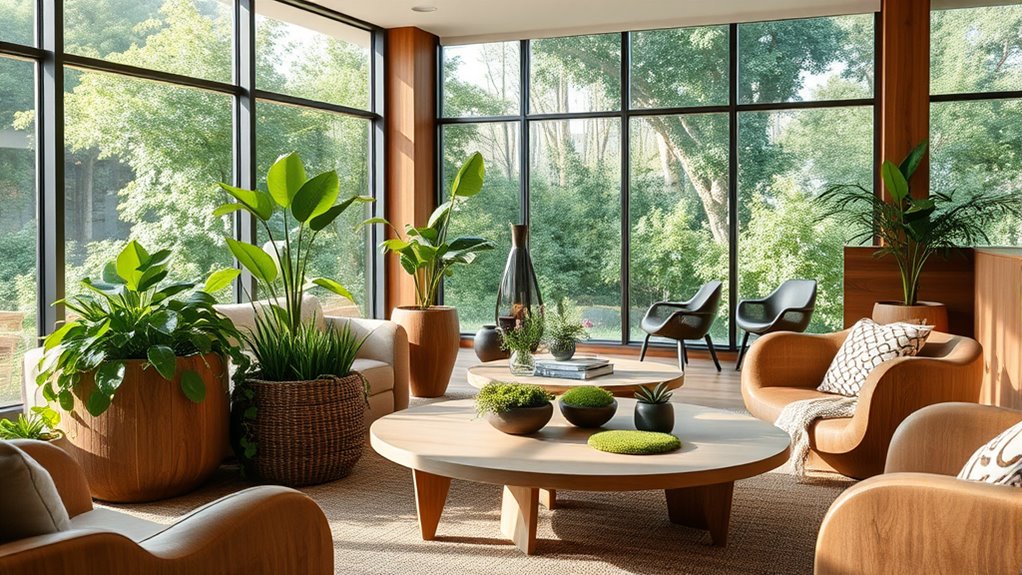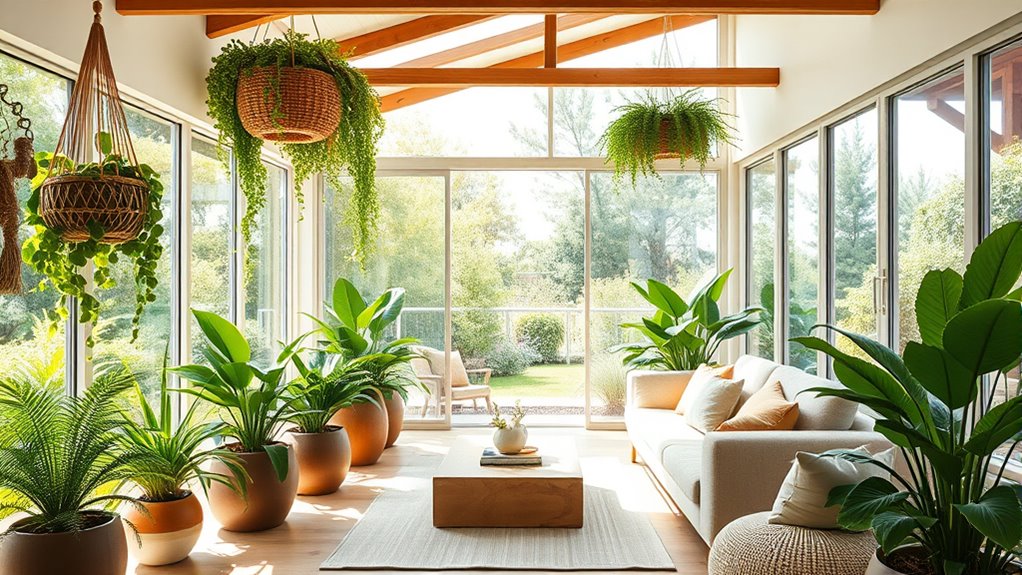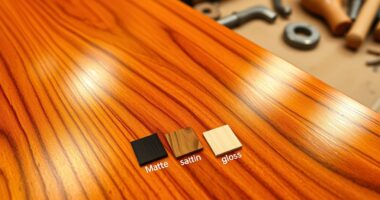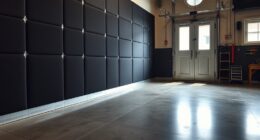In 2025, biophilic design is shaping furniture trends by focusing on natural materials like reclaimed wood, stones, and eco-friendly textiles. You’ll notice earthy tones, calming colors, and designs that connect you to nature through organic textures and patterns. Sustainable sourcing and multifunctional furniture with built-in greenery make spaces more restorative. If you stay tuned, you’ll discover how these elements can transform your environment into a healthier, more harmonious place.
Key Takeaways
- Increasing use of organic materials and natural textures creates more inviting, tactile furniture aligned with biophilic principles.
- Earthy color palettes and natural hues dominate interior designs, fostering calming, nature-inspired environments.
- Sustainable sourcing and reclaimed materials support eco-conscious furniture trends in 2025.
- Integration of living plants and green elements enhances mental well-being and strengthens indoor-outdoor connections.
- Multifunctional and innovative designs incorporate natural elements, promoting healthier, restorative living spaces.

Biophilic design is transforming furniture trends in 2025 by bringing nature directly into your living and working spaces. You’ll notice this shift through the use of organic materials like reclaimed wood, natural stones, and eco-friendly textiles that create a tactile connection to the outdoors.
Instead of relying on bright, artificial colors, designers favor earthy tones such as deep greens, terracotta, and soft creams. These colors evoke outdoor environments, fostering calmness and groundedness in your surroundings. The focus is on subtle, organic textures and patterns that mimic natural forms, moving away from rigid geometric shapes to create furniture that feels more alive and inviting.
This approach emphasizes sustainability, with an emphasis on responsible sourcing, reducing waste, and choosing recyclable or reclaimed materials to lessen environmental impact. You’ll see furniture pieces that aren’t only beautiful but also eco-conscious, supporting a more sustainable lifestyle. Incorporating sustainable practices in furniture design further enhances this movement toward environmentally responsible living.
The integration of natural elements in furniture is more than aesthetic; it’s about enhancing your mental well-being. Incorporating natural materials and daylight into your space can elevate your mood, reduce stress, and promote emotional balance. Research shows that biophilic environments can significantly improve mental health and cognitive function. Additionally, incorporating natural lighting enhances the connection to the outdoors and supports circadian rhythms, further benefiting well-being.
Spaces designed with biophilia help you relax and recharge, making your environment more restorative. Increased exposure to organic textures and natural light improves concentration and productivity, creating an ideal atmosphere whether you’re working from home or relaxing with family.
Additionally, furniture often incorporates living plants or supports indoor gardens, blurring the line between indoor and outdoor environments. These living elements not only boost your aesthetic experience but also improve air quality and overall health.
Color palettes in biophilic design lean toward muted, natural hues that foster a sense of groundedness. Instead of sterile whites or artificial brights, expect to see warm browns, deep greens, and terracotta shades dominating interior spaces.
These hues offer versatility across different styles while maintaining a strong connection to nature. The overall aesthetic promotes a calming, immersive environment that aligns with the broader trend of dark and earthy interior schemes in 2025.
Functionality also plays a vital role; many pieces are designed to be multifunctional, incorporating built-in planters or green walls that maximize your connection to nature without sacrificing practicality.
This fusion of form and function ensures your furniture isn’t just visually appealing but also enhances your daily life.
In 2025, biophilic furniture isn’t just a trend—it’s a movement toward creating healthier, more sustainable, and more harmonious living environments. You get to enjoy the beauty and serenity of nature indoors, knowing your choices support eco-conscious practices.
The emphasis on natural materials, earthy colors, and innovative design makes your space both stylish and nurturing, aligning with the growing desire for more meaningful and environmentally responsible living.
Conclusion
Just as nature’s timeless beauty continues to inspire, biophilic design in furniture invites you to reconnect with the world outside your door. By embracing these trends, you’re not just decorating a space—you’re creating a sanctuary that nurtures your well-being. Think of it as carving out your own piece of Eden amid modern chaos. As the saying goes, “In nature, we find our true selves,” and now, your home can be the reflection of that harmony.









